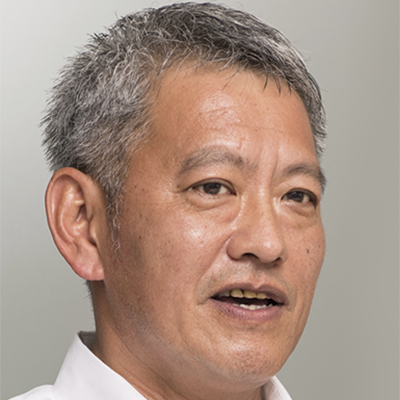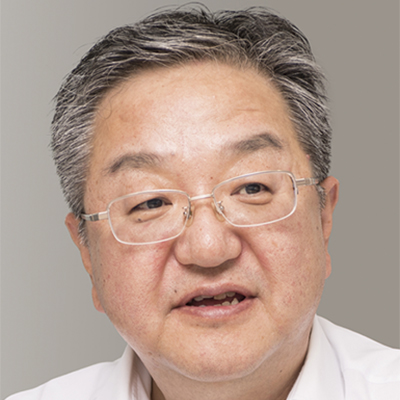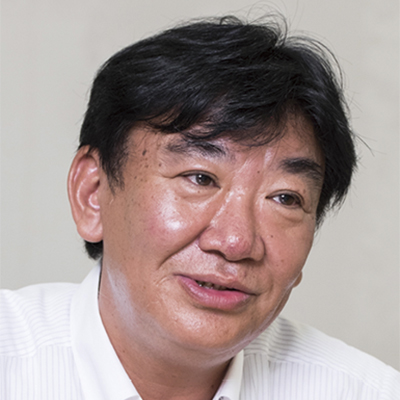The Corporate Role in Developing a Sustainable World
Industrial development through innovation has improved economies and revolutionized life and society primarily in developed countries, as evidenced by the first industrial revolution in the 18th century with steam locomotives, the second revolution in the 19th with electrical devices, and the third industrial revolution in the 20th centuries with electronics. As a result, it has become possible to live a life in which basic safety and security are protected, with electricity, gas, and water becoming social infrastructure, and various modes of transportation and communications can be employed.
However, the rapid development of industry and economy has also led to environmental issues such as climate change that may seriously impact humanity in the future. In addition, the uneven distribution of wealth has led to the expansion of global economic disparities.
Faced with such challenges, society's values, lifestyles, and corporate management have begun to change. The concept of “sustainability” has now broadly penetrated into society, prompting reconsideration of attitudes that prioritize economic efficiency alone. This concept has expanded industry and the economy while protecting the future global environment, with the aim of allowing all people on the earth to fairly receive the benefits of society. Sustainable corporate growth and improvement of corporate values is increasingly viewed as requiring environmental, social, and governance (ESG) viewpoints, and these elements are influencing the decision making of institutional investors (see Figure 1).
The Sustainable Development Goals (SDGs), which form the core of the 2030 Agenda for Sustainable Development adopted by the United Nations in 2015, are key strategic targets for companies focused on ESG. While their predecessor, the Millennium Development Goals, mainly addressed poverty in developing countries, the SDGs target the state of the global economy and society including developed countries, and have a relatively short-term target of 2030. This is due to a sense of crisis—a feeling that if worldwide transformation is not accelerated, the opportunity to correct disparities and restrain humanity's environmental load to sustainable levels will be missed.
Another feature of SDGs is that companies are positioned as one of their main implementers. A key to overcoming various challenges in sustainable development is innovation and investment from private enterprises. Amid such trends, global companies have already begun efforts to integrate SDGs into their management strategies and to link development targets with their business. The ability to respond to social issues has become a driving force behind corporate innovation, thus influencing competitiveness.
Basic Conditions for Living: Securing Water
 Kunihiko Okano
Kunihiko Okano
General Manager, Water Solutions Division, Water Business Unit; General Manager, Global Division, Water Business Unit, Hitachi, Ltd.
There are diverse elements to fundamental human rights and right to life—that is, securing the right of human beings to live as human beings—but among them life infrastructure, particularly water infrastructure, is indispensable. This is presented as goal 6 of the SDGs, “ensuring access to water and sanitation for all.” Water not only directly relates to maintaining life, but is also indispensable to food production. To maintain hygienic living environments and prevent infectious diseases, it is necessary to provide a safe water supply and sanitation measures. Yet, despite being such a vital resource, many countries throughout the world are facing water issues. Particularly in recent years, a combination of factors in emerging and developing countries—increased populations, increasing concentration of the population in urban areas, and higher living standards due to economic development—has increased water demand and degraded the water environment (see Figure 2).
Japan is blessed with water resources that provide relatively little worry of drought, but frequently experiences damage in torrential rains due to climate change, making management of flood control and the water environment increasingly important.
Regarding contributions toward solving domestic and overseas water issues, Kunihiko Okano (General Manager, Water Solutions Division, Water Business Unit; General Manager, Global Division, Water Business Unit) says the following.
“Providing a sustainable, safe water supply is a universal task, one that requires multifaceted efforts based on the circumstances of the country or region. Hitachi is promoting its Social Innovation Business, which aims at solving customers' and society's challenges by applying digital technologies to social infrastructure, and solutions in the water environment field are one of the important themes.
“Through collaborative creation with customers and partners, Hitachi is working to develop products, systems, and services that address various challenges at home and abroad, including water-source conservation, flood control, water supply and sewerage, securing of water resources through desalinization and water reclamation, and wastewater treatment. Applying our accumulated technologies for monitoring control and water treatment and our broad range of product groups, we are combining operational technology (OT) and information technology (IT) to contribute to reducing the burden on the water environment and ensure a stable water supply. By applying the Internet of Things (IoT) platform Lumada, we will further advance demand forecasting, wide-area surveillance and control, predictive diagnosis, etc., and contribute to lowering capital investment and operational costs.”
Figure 2Global Water Environment: Available Water Resources Source: UN Water, The United Nations World Water Development Report 2014
Source: UN Water, The United Nations World Water Development Report 2014
The 100-year History of Hitachi's Water Environment Business
 Chuko Kirikoshi
Chuko Kirikoshi
General Manager, Social Infrastructure Systems Division, Water Solutions Division, Water Business Unit, Hitachi, Ltd.
The start of Hitachi's water environment business began at its founding, about 100 years ago. Alongside motors, pumps, which support water supply and sewerage systems, are among Hitachi's oldest products. Hitachi succeeded in increasing the size and reliability of its pumps by using Japanese technologies, thereby spreading the products both domestically and overseas in various fields, from coal mine drainage to industrial, water supply, and power generation applications.
Starting with electrical system control panels delivered to Tokyo's Kanamachi Water Purification Plant in 1934, Hitachi has increased the functionality of monitoring and control systems to support operations by incorporating control and simulation by means of computing and software technologies, thereby contributing to increased sophistication of water supply and sewerage systems. Chuko Kirikoshi (General Manager, Social Infrastructure Systems Division,Water Solutions Division, Water Business Unit) states the following.
“From the dawn of water supplies and sewerage systems until today, Hitachi has collaboratively created solutions to challenges faced in each era along with people working in water supply and sewerage enterprises. We have also engaged in technology development with countries and various partners. We are unifying the wide range of technologies we have cultivated, and by adding the latest digital technologies and considering the flow of both water and information, we have proposed the intelligent water system concept for system-wide optimization of water circulation over wide areas, such as cities and water basins (see Figure 3). We will respond to diversifying water challenges, not only by responding to domestic water issues such as maintenance of aged facilities and technology inheritance, but also by contributing to increased sophistication of overseas water infrastructure and reduced environmental impact.”
In the future, the declining population is predicted to decrease domestic demand for water supply and sewerage systems, and there are projections showing a lack of technical staff, so there are progressing trends toward consolidation where water supply and sewerage projects are jointly carried out by multiple business entities, expansion of public–private partnerships, and the like. Hitachi is working to develop solutions that contribute to optimization and efficiency of the entire water business, for example, by participating in demonstration projects by the Ministry of Economy, Trade and Industry that apply cyber–physical systems and the IoT to the operation of water infrastructure to contribute to consolidation of multiple municipalities.
As an example of public–private partnerships, Toda City in Saitama Prefecture ordered a five-year full-service outsourcing of its water supply and sewerage operations that combines customer service and facility operation management services.
There are various needs overseas, such as introduction of advanced technologies for seawater desalination, operation and management of water supply pipes connecting households with water purification plants, and measures against water leakage. In particular, seawater desalination is attracting attention as a measure against drought in areas with limited freshwater resources. Regarding Hitachi's efforts toward reducing power consumption at seawater desalination plants in cooperation with partner companies and others, Okano says the following.
“Conventional reverse osmosis membrane-type seawater desalination plants remove salt from seawater by passing it at high pressure through a membrane with fine pores, so reducing the power consumption of the pumps used is a challenge. We devised an array of cylindrical pressure vessels containing membranes. Controlling and equalizing the flow rate of seawater passing through each membrane contributes to reducing power consumption and equipment costs, as well as to reducing the environmental load due to wastewater. This technology was developed along with the New Energy and Industrial Technology Development Organization (NEDO) and Toray Industries, Inc. as part of the Mega-ton Water System, under the Japan Cabinet Office's Funding Program for World-Leading Innovative R&D on Science and Technology, and is currently being conducted as a demonstration project in the Kingdom of Saudi Arabia. In addition, Hitachi is also engaged in collaborative creation with NEDO, Kitakyushu City, partner companies, and others, to create a system that reduces reverse osmotic pressure by diluting seawater with treated sewage water, and is applying the results in a demonstration project in the Republic of South Africa. We will continue to lead in next-generation water infrastructure through collaborative creation with advanced technologies and partners, aiming to become a “comprehensive water service provider” that contributes to markets and to customers' problem solving.”
Figure 3Overview of the Hitachi Intelligent Water Systems Concept
Basic Conditions for Living: Ensuring Safety and Security
The development of infrastructure for livelihoods, including water infrastructure, is essential for improving the living environment in developing and emerging countries. In developed countries, stable and sustainable maintenance of living infrastructure is an issue. Against this background, “resilience” is starting to be emphasized.
Resilience refers to “the ability for quick, overall recovery after part or the whole of social systems or part of a business ceases functioning due to risks such as disasters, terrorism, or unexpected environmental changes,” and in recent years has been increasingly incorporated into governmental disaster prevention plans and corporate business continuity plans. Water infrastructure is related to all aspects of daily life. Hitachi's water environment solutions aim to make water infrastructure more intelligent and capable of withstanding various risks, and therefore can be considered as an effort toward increasing the resilience of water infrastructure. Security against new threats and disaster prevention or mitigation measures against natural disasters are essential for protecting basic human rights and the right to life. Worldwide security threats such as increases in refugees due to combined political and economic factors and frequent terrorist attacks are growing, as are large-scale, life-threatening natural disasters such as torrential rains and heatwaves due to the effects of climate change. For this reason, in the West, in particular, there are movements toward clarifying what infrastructure should be protected in emergencies, how to maintain lifeline supply systems, and how to address not only national security but also economic resilience.
There are concerns that Japan will also experience increased risk of terrorism at large international events in the future. Regarding natural disasters, the extensive damage resulting from the Great East Japan Earthquake demonstrated the importance of not only facility protection but also quick recovery of entire systems, prompting the development of the “Fundamental Plan for National Resilience” that calls for “strong and resilient” national security and economic and social systems.
Protecting Infrastructure Systems in a Highly Uncertain Society
 Hiroshi Saito
Hiroshi Saito
President, Security Businesses Division, Services & Platforms Business Unit, Hitachi, Ltd.
Both domestically and overseas, globalization and digitalization are increasing interdependence of economic and social systems, and thus the impact of partial dysfunction tends to become widespread. Various systems and products such as mutual collaboration of infrastructure systems, enterprise value chain, and the IoT are being connected in ways that transcend traditional frameworks and borders. This allows today's society to create value, but the downside is that it is difficult for nations and organizations to cope with risks on their own. It is important to build systems that respond by cooperating and coordinating with each other even in emergencies, while simultaneously improving their own security.
For many years, the Hitachi Group has been supporting social infrastructure as a lifestyle foundation with its customers, contributing to the realization of stable supplies of high-quality water and energy, reliable and accurate train operations, and so on.
Based on an approach of protection at the system, organization, and operational levels, Hiroshi Saito (President, Security Businesses Division, Services & Platforms Business Unit) describes the concept of protecting the security of social infrastructure and improving resilience as follows.
“At Hitachi, we believe that there are four important requirements for realizing our social infrastructure security concept: hardening, adaptive, responsive, and cooperative (see Figure 4). Creating a resilient security infrastructure as a foundation on which we construct a flexible and adaptive system that can continuously strengthen advance measures against threats will realize operations that can quickly respond to disasters and incidents. The idea is to protect social infrastructure by sharing information and coordinating operations with other organizations.
“A society symbolized by the multifaceted connectivity of the IoT creates unprecedented value, but will likely also encounter unforeseen circumstances. In such a highly uncertain society, security cannot be protected by conventional measures such as removing the cause of past accidents. Enhancing business continuity and realizing a strong, flexible society in the IoT era will of course require not only the ability to cope with unexpected changes, but also disaster and security policies based on disaster mitigation that minimizes damage, rapid situation analysis, and prevention of secondary damage.”
Resilience Required in the IoT Era
Based on this security concept, Hitachi provides solutions that combine various physical- and cyber-based security technologies. Doing so contributes to improving the safety and security of not only important domestic facilities, but also those overseas as well. Special emphasis is placed on security solutions for the IoT era.
As Saito describes it, “With the spread of IoT, control systems for important social infrastructure which were previously independent from external networks have come to be indirectly connected to the Internet, increasing the risk of cyberattacks. Business continuity that maintains services in the event of a crisis is an important point in the security of social infrastructure that is deeply involved in daily life. It is necessary to evolve business continuity plans, newly applying to cyberattacks previous measures designed for major natural disasters. This is true resilience, and we cannot simply apply conventional ideas of information security that were mainly conceived for data protection. Hitachi utilizes knowledge of the construction and operation of the social infrastructure systems that it has cultivated under its new security vision, ‘evolving security for changing IoT world,' and we aim at improving our customers' business and social resilience through internally proven security technologies with OT × IT environments.”
Efforts toward disaster prevention and mitigation are indispensable to raising the resilience of society as a whole. In the past, local governments, companies, and citizens have independently prepared themselves, but countermeasures through public–private partnerships are needed to reduce to the extent possible the impact of disasters that will cause stagnation of social and economic activities.
One example is the evolution of Japan's fire command system. Hitachi has previously developed multiple firefighting command systems, including that used by the Tokyo Fire Department, allowing for smooth information sharing among officials and divisions by utilizing IT, and providing high-level firefighting directive systems that shorten command and response times. Hitachi has also proposed concepts for a next-generation command center, aimed at realizing features such as smartphone-based emergency notifications and optimized emergency transportation through advanced analysis. By continuing to utilize digital technologies such as the IoT and artificial intelligence in the future, it will be possible to realize things such as rapid information gathering, centralized management, analysis, and simultaneous distribution of necessary information during disasters, allowing for appropriate responses when disasters occur.
Accelerating Collaborative Creation and Overcoming the Challenges of Global Society
In the realization of the “super smart society” proposed by the Japanese government under its Society 5.0 concept, improving social resilience is an important theme. Overcoming the challenges that Japan faces—including a decreasing population due to a declining birthrate and aging population, and natural disasters such as earthquakes—will require tackling many issues, such as utilizing digital technology to increase the sustainability and resilience of infrastructure, and disaster prevention and mitigation measures from a variety of perspectives. Tackling these issues, however, will make us stronger. By developing achievements throughout the world, it is possible to contribute to overcoming the challenges that global society faces, including those that are targets of the SDGs. Hitachi will promote collaborative creation that aims to solve challenges together with its customers and partnerships both in Japan and overseas, and by combining infrastructure control technology with products and evolving digital technologies will accelerate its Social Innovation Business. Beyond that lies a future in which everyone can live in safety and security, protected by strong, resilient lifestyle infrastructure.


